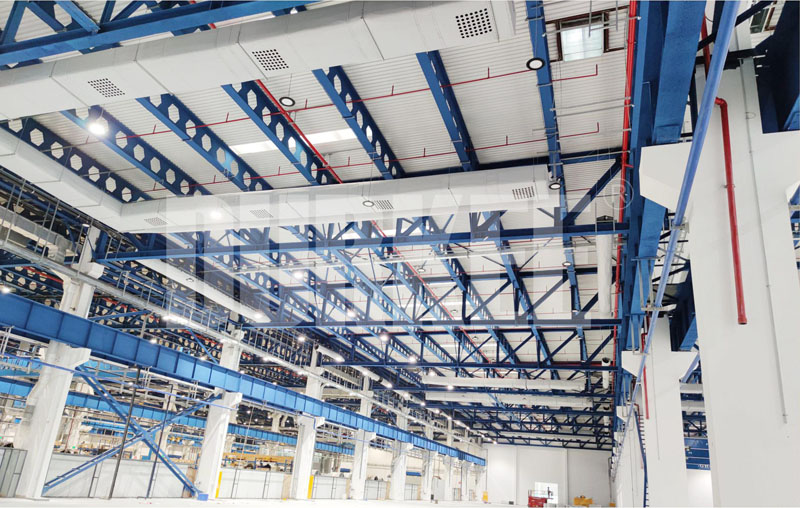 BOE Vietnam Factory: Non-rigid Air Duct Solutions for Electronic Industry
BOE Vietnam Factory: Non-rigid Air Duct Solutions for Electronic Industry
 Why Fabric Air Ducts Are the Preferred Choice for Ventilation in Large Spaces
Why Fabric Air Ducts Are the Preferred Choice for Ventilation in Large Spaces
 The Difference Between Non-Rigid Air Ducts and Rigid Ductwork
The Difference Between Non-Rigid Air Ducts and Rigid Ductwork
In any HVAC (Heating, Ventilation, and Air Conditioning) system, the efficient circulation of air is paramount for maintaining a comfortable indoor environment. The two primary components responsible for this air circulation are the supply ducts and return ducts. While both are essential for a balanced and effective HVAC hvac duct sock system, they serve distinct functions. This article will elucidate the differences between supply ducts and return ducts, examining several key aspects including their identification, temperature differences, and optimal placement, with a special focus on the brand Durkduct.

First and foremost, it's crucial to understand the core functions of supply and return ducts. The supply duct is responsible for distributing conditioned air (either cooled or heated) from the HVAC fabric duct system into various spaces within a facility. In contrast, the return duct funnels air from the indoor environment back to the HVAC system for reconditioning.
- Supply Duct : Carries freshly conditioned air to different places.
- Return Duct : Collects indoor air and returns it to the HVAC unit for reconditioning.
Identifying supply and return ducts might seem complex, but there are some tell-tale signs that can help distinguish between the two.
- Supply Ducts:
- Often attached to vents located nearer to the floor in heating systems to ensure warm air rises.
- Can also be found near the ceiling in cooling systems to allow cool air to sink.
- Typically equipped with adjustable louvers or registers.
- Return Ducts:
- Usually found on walls or ceilings.
- More likely covered with a grille, which is often larger and has no adjustable slats.
- Temperature: The air coming out of the supply vents should feel cooler (in the summer) or warmer (in the winter) compared to the facility’s temperature. Conversely, return air vents will draw in facility-temperature air.
- Airflow: Hold a piece of tissue near the vent; if it gets blown away, it’s a supply duct, and if it gets sucked in, it’s a return duct.
The temperature difference between supply air and return air is a critical measure of an HVAC system's efficiency.
- Cooling Mode: The supply air should be around 15-20 degrees Fahrenheit cooler than the indoor air that is being returned.
- Heating Mode: The supply air should be approximately 15-20 degrees Fahrenheit warmer than the return air.
Accurate temperature measurement can be achieved using a reliable HVAC thermometer placed near the supply and return vents. A significant deviation from these values could indicate an issue with the HVAC system, such as a refrigerant leak, dirty filters, or inadequate insulation in the ducts.
The placement of supply and return ducts is pivotal for optimal HVAC system performance, ensuring even temperature distribution and reducing energy consumption. Here’s a guideline on where you should ideally place these ducts:
- Living Spaces: Often installed in areas where people spend the most time, such as offices.
- Floor or Ceiling: In cooler climates, floor installation is common to allow warm air to rise. In warmer climates, ceiling or high on the wall installations are preferred to let the cool air fall.
- Central Locations: Placed centrally in facilities to efficiently collect air from the entire space.
- High or Low: In heating applications, low return vents help pull in cooler air from the floor, while in cooling applications, high return vents are more effective in pulling warmer air from the ceiling.
Strategic placement ensures a balanced airflow, which is crucial for system efficiency and indoor comfort. Durkduct, a well-regarded brand in the HVAC industry, offers a variety of high-quality ducts designed to maximize airflow efficiency and performance.
Understanding the differences between supply ducts and return ducts is essential for anyone looking to optimize their HVAC system's performance and ensure a comfortable living environment. The supply ducts distribute conditioned air throughout the facility, while the return ducts bring indoor air back to the HVAC unit for reconditioning. Identifying these ducts is straightforward through visual and functional indicators, and the correct placement can significantly impact the HVAC system's efficiency.
Maintaining the ideal temperature difference between supply and return air is crucial for assessing system performance. Using high-quality products like air sock ductwork from Durkduct can further enhance your HVAC system’s reliability and efficiency. Proper knowledge and management of supply and return ducts not only contribute to better energy efficiency but also ensure a consistently comfortable indoor climate.